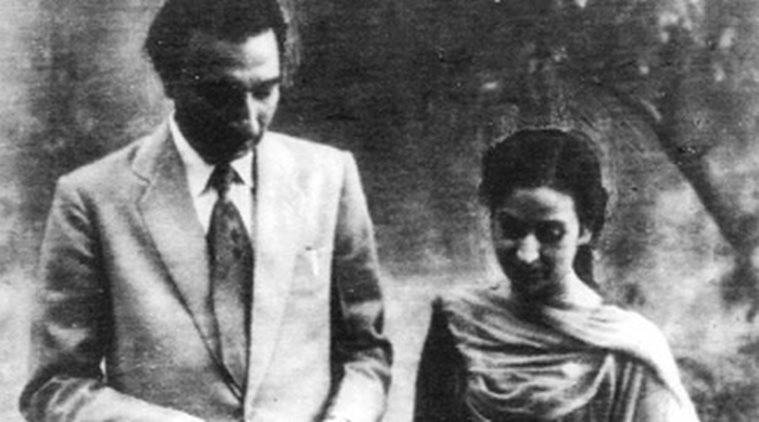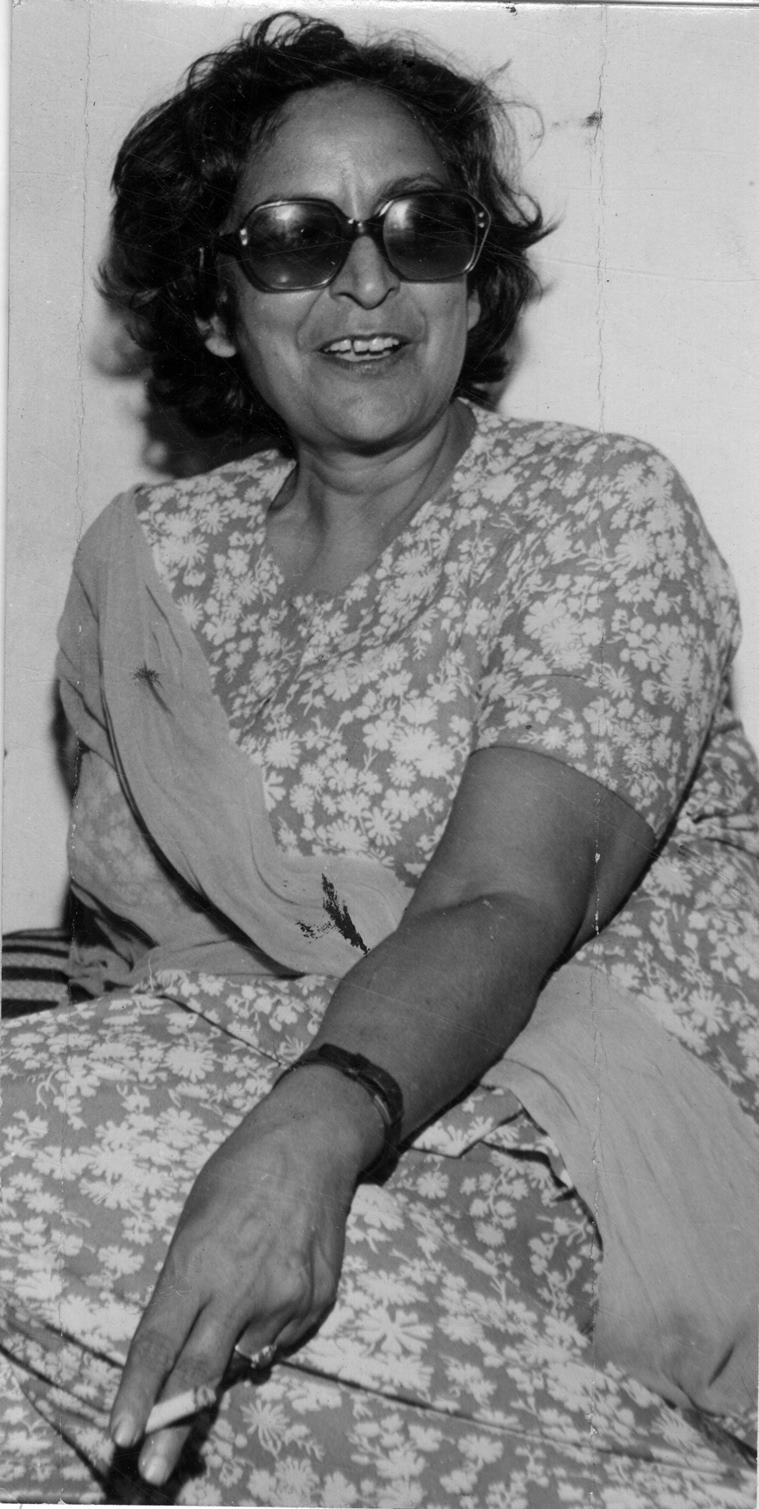- India
- International
The intriguing love story of Amrita Pritam and Sahir Ludhianvi
Amrita Pritam knew that Sahir had a commitment phobia and his love for her was not as intense. She wrote to him, "Maine toot ke pyaar kiya tum se/Kya tumne bhi utna kiya mujh se? (I loved you wholeheartedly/ Did you also love me that much?)".
 Somewhere, Amrita Pritam knew Sahir’s love for her was not as intense. (Source: Express Archives)
Somewhere, Amrita Pritam knew Sahir’s love for her was not as intense. (Source: Express Archives)
Muhabbaton ki parakh ka yahi toh rasta hai
Teri talaash mein nikloon, tujhe na paaoon main
(The best criterion to judge the intensity of love is never to get the person who one loves).
Mazhar Imam’s Urdu couplet was Amrita Pritam’s favourite as it summed up her love for Sahir Ludhianvi. On the 100th birth anniversary of Amrita Pritam on August 31, it won’t be wide off the mark to once again descant upon this intimately intriguing love, that went beyond the precincts of conventional man-woman love.
Nobel laureate Pablo Neruda wrote, “Difficult is to define love; all the more tricky to define ours…” Neruda’s words are apt for Amrita and Sahir’s love. Theirs was a kind of love that cannot be described but felt — Sirf ahsaas hai ye rooh se mahsoos karo, pyaar ko pyaar hi rahne do koi naam na do (It’s a feeling to be felt by the soul/Let love remain love, don’t defile it by giving a name).
ALSO READ | Amrita Pritam lives on in hearts of many through her words, nazms

Both were intellectually inclined individuals who admired each other’s creativity. Isn’t admiration often akin to love? Just like French existentialists Jean-Paul Sartre and Simone de Beauvoir, Sahir and Amrita soon fell in love. In fact, in an interview to Hindi magazine Kadambini, Amrita told interviewer Dharmveer Bharti, “Sahir mere Sartre aur main unki Simone thi (Sahir was my Sartre and I was his Simone)”. They were each other’s muse just like the Victorian English poet Robert Browning and Elizabeth Barrett Browning. In the book Parallelism in Cerebral Love Affairs, Dennis Williams writes that two intense personalities with intellectual leanings naturally come closer and eventually fall in love; the basic conditions of mundane love don’t work here.
Amrita was very pretty, whereas Sahir had a pockmarked face with an unimpressive gait. Sartre was distinctly squinted and short but Simone was correspondingly elegant. German philosopher Emmanuel Kant was very short but his muse Eliza was exceptionally beautiful and also taller than him. The list of odd couples is endless.
 Amrita Pritam (Source: Express Archives)
Amrita Pritam (Source: Express Archives)
Amrita had a sapiosexual crush on Sahir, whom she adored as qalam ka jaadugar (wizard of pen). In fact, the very takhallus (nom de guerre) of Sahir — his actual name was Abdul Hayee — means a magician. Unhappy in a suffocating marital bond, Amrita looked for freedom; freedom of soul, spirit and mind. “Tumhare darakht ki tahani ka jo aasra mila/Mere toote hue dil ka parinda wahin ruk gaya (When I found the branch of your tree/ The bird of my broken heart perched there permanently)”. Amrita wrote this couplet to Sahir in the initial days of their courtship.
Deeply committed to his mother Sardar Begum, Sahir had a quasi-oedipal predilection for Amrita as she was also a couple of years older to him. Though both loved each other quite profoundly, it was Amrita who loved Sahir more, vindicating Byronic dictum in Don Juan — ‘Man’s love is in a man’s life, a thing apart/’Tis a woman’s whole existence.’ “Main tumhari hokar rah gayee/Tum mera mukammal vajood ban gaye (I became yours/You became my whole existence)”.
ALSO READ | Amrita Pritam’s poem inspires opening lines in Delhi High Court’s verdict
Somewhere, Amrita knew that Sahir had a commitment phobia and his love for her was not as intense. Elsewhere, she wrote to him, “Maine toot ke pyaar kiya tum se/Kya tumne bhi utna kiya mujh se? (I loved you wholeheartedly/ Did you also love me that much?)”. In fact, this couplet appeared in her last letter to Sahir which she personally handed over to him and had the last cup of coffee and a fag with the mercurial poet.
While leaving Sahir’s place for the last time, Amrita quoted Byron (she seldom quoted English poets): “In her first love, woman loves her lover/ In all the others, all she loves is love.” Sahir calmly asked her, “Aap jaane se pahle iska tarjuma kar dengi? (Before leaving, will you please translate it?)”. Amrita wrote in her memoirs that whenever Sahir was not happy with her or sulking, he’d use aap for her instead of tum.
 Film director Satyajit Ray, writer Amrita Pritam and Carnatic singer MS Subbalakshmi with Indira Gandhi in Delhi. (Source: Express Archives)
Film director Satyajit Ray, writer Amrita Pritam and Carnatic singer MS Subbalakshmi with Indira Gandhi in Delhi. (Source: Express Archives)
Their last meeting was very poignant. Pakistani activist and Amrita Pritam’s dear friend, the late Fahmida Riyaz wrote a piece — Amrita ki Sahir se aakhri mulaaqaat: Amrita’s last meeting with Sahir) — in Pakistani Urdu daily Jung. Amrita told her that while parting, Sahir said poetically to her: Tum chali jaaogi, parchhaiyaan rah jaayengi/Kuchh na kuchh Ishq ki raanaaiyaan rah jaayengi (Fahmida figuratively translated it: When you leave, your lovely silhouettes shall remain/ Memories and traces of love will smart me time and again). This impromptu couplet was later to be immortalised in Muhammad Rafi’s voice for Shagoon (1964), replacing ishq with husn. This is the only instance when Sahir requested Rafi for a retake despite the fastidious Khayyam okaying the number. He requested Rafi to sing it again to capture the essence of the word Raanaaiyaan because he added: “Ye Amrita ke liye hai, chunanche aapko zahmat dee (I’ve troubled you because it’s for Amrita!).” Rafi obliged wholeheartedly.
Though separated, both could never forget each other. Sahir fell for Sudha Malhotra but Amrita remained his only love. And when he got to know Amrita found someone (Imroz), he wrote, “Mujhe apni tabahiyon ka koi gham nahin/ Tumne kisi se muhabbat nibaah toh dee (I’m not sad over my losses and ruins/ I’m happy that finally you found someone worth living for)”. Thus ended a tragic love affair with a very sound piece of advice to all future lovers:
Ta’arruf rog ho jaaye toh usko bhoolna behtar
Ta’alluq bojh ban jaaye toh usko todna achchha
Woh afsana jise takmeel tak laana na ho mumkin
Use ek khoobsoorat mod dekar chhodna achchha
(If familiarity becomes a disease, it’s better to forget it/If a relationship becomes a burden, better to break it/An affair that can’t reach its logical end/It’s advisable to leave at a pleasant turn).
It’s worthwhile to mention that anjaam in lieu of takmeel is only for the song to set its tune: Chalo ik baar phir se ajnabi ban jaayein hum dono(n) in the film Gumraah [1963] (Lyrics: Sahir Ludhianavi, Music: Ravishankar Sharma).
But then, love is love when it’s unrequited. We’d not have been writing reams of paper, had their love ended on a happy note. Lastly, to quote Sahir from his collection, Talkhiyaan: Muhabbat jo anjaam tak pahunchi nahin/Wahi muhabbat hai, baaqi kuchh nahin (Love that remains unfulfilled/Is the true love, the rest doesn’t matter).
More Lifestyle
Apr 25: Latest News
- 01
- 02
- 03
- 04
- 05




































